John Avina, C. E. M.
Director, Abraxas Energy Consulting
November 22, 2012
Utility Bill Tracking: The Report Card for Alternative Energy Contractors
More and more, alternative energy contractors want to prove to customers the savings they expect. Customers often want to know that they have saved the energy and costs they were originally promised. From the customers’ viewpoint, the simplest and most understandable proof of energy savings comes from a simple comparison of electricity bills. Did the system save on electricity costs or not?[1] In theory, a simple comparison of pre-installation bills to post-installation bills, and you will see if you have saved.
But if it is so easy, why write a paper on this? Well, it isn’t so easy. Let’s find out why.
Suppose a solar energy contractor installed a new solar electric system for a building. One likely would expect to see energy and cost savings from this retrofit. Figure 1.1 presents results our alternative energy contractor might expect.
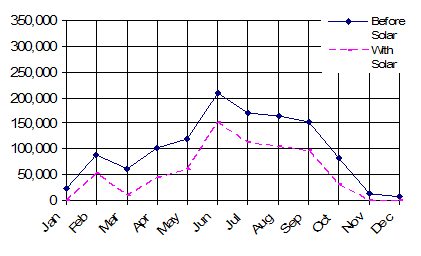
Figure 1.1: Expected Pre and Post-Retrofit usage for chilled water system retrofit.
But what if, instead, the bills presented the disaster shown in Figure 1.2?
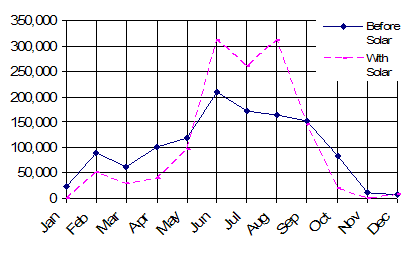
Figure 1.2: A disaster of a project? Comparison of Pre-Retrofitand Post-Retrofit data
Imagine showing a customer these results after they have invested hundreds of thousands of dollars in your system. It is hard to inspire confidence in your abilities with results like this.
How should the solar energy contractor present this data to customer?Do you think the contractor would be feeling confident about the job, and about getting referrals for future solar projects?Probably not. The customer might simply look at the figures and, since figures don’t lie, conclude they have hired the wrong contractor,
and that the solar system doesn’t work very well!
There are many reasons the system may not have delivered the expected savings. A possibility is that the project is delivering savings, but the summer after the installation was much hotter than the summer before the installation. Hotter summers translate into higher air conditioning loads, which could result in higher utility bills.
Hotter Summer -> Higher Air Conditioning Load -> Higher Summer Utility Bills
In our example, we are claiming that because the post-installation weather was hotter, the solar electric project looked like it didn’t save any energy, even though it really did. Imagine explaining that to customers! If the weather really was the cause of the higher usage, then how could you ever use utility bills to measure savings from solar energy projects? Your savings numbers would be at the mercy of the weather. Savings numbers would be of no value at all (unless the weather was the same year after year).
Our example may appear a bit exaggerated, but it begs the question: Could weather really have such an impact on savings numbers?
It can, but usually not to this extreme. The summer of 2005 was the hottest summer in a century of record-keeping in Detroit, Michigan. There were 18 days at 90°F or above, compared to the usual 12 days. In addition, the average temperature in Detroit was 74. 8°F compared to the normal 71. 4°F. At first glance, 3 degrees doesn’t appear significant, however, if you convert the temperatures to cooling degree days [2], as shown in Figure 1.3, the results look dramatic. Just comparing the June through August period, there were 909 cooling degree days in 2005 as compared to 442 cooling degree days in 2004. That is more than double! Cooling Degree Days are roughly proportional to relative building cooling requirements. For Detroit then, one can infer that an average building required (and possibly consumed) more than twice the amount of energy for cooling in the summer of 2005 than the summer of 2004. It is likely that in the Upper Midwestern United States there were several solar contractors who faced exactly this problem!
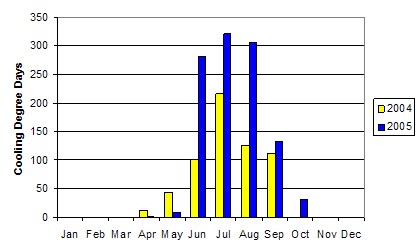
Figure 1.3: Cooling Degree Days in Detroit, Michigan for 2004 and 2005
How is a solar energy contractor going to show savings from a solar electric system under these circumstances? A simple comparison of utility bills will not work, as the expected savings will get buried beneath the increased cooling load. The solution would be to somehow apply the same weather data to the pre- and post-installation bills. Then there would be no penalty for extreme weather. This is exactly what weather normalization does. To show savings from a retrofit (or good alternative energy practice), and to avoid our disastrous example, an alternative energy contractor should normalize the utility bills for weather, so that changes in weather conditions will not compromise the savings numbers.
The practice of normalizing energy bills to weather is catching on, with more and more energy managers, energy engineers, and contractors correcting their bills for weather because they want to be able to prove that they are actually saving energy from their efforts. This process has many names: weather correction, weather normalization, tuning to weather, tuning, or weather regression.
How Weather Normalization Works
Rather than compare last year’s usage to this year’s usage, when we use weather normalization, we compare how much energy we would have used this year to how much energy we did use this year. Many in our industry do not call the result of this comparison, “Savings”, but rather “Usage Avoidance” or “Cost Avoidance” (if comparing costs). But, since we are trying to keep this chapter at an introductory level, we will simply use the word Savings.
When we tried to compare last year’s usage to this year’s usage, we saw Figure 1.2, and a disastrous project. We used the equation:
Savings = (Last year’s usage) – (This year’s usage)
When we normalize for weather, the same data results in Figure 1.4, and uses the equation:
Savings = (How much energy we would have used this year) – (This year’s usage)

Figure 1.4: Comparison of Baseline and Actual (Post-Retrofit) data with Weather Correction
The next question is, how do we figure out how much energy we would have used this year? That is where weather normalization comes in. First, we select a year of utility bills[3] to which we want to compare future usage. This would typically be the year before you started your alternative energy program, the year before you installed a retrofit, or the year before you, the new energy contractor, were hired, or just some year in the past that you want to compare current usage to. In this example, we would select the year of utility data before the installation of the solar electric system. We will call this year the Base Year [4].
Then we calculate degree days for the Base Year billing periods. Because this example is only concerned with cooling, we need only gather Cooling Degree Days (not Heating Degree Days). A section on calculating Degree Days follows later in the chapter. For now, recognize only that Cooling Degree Days need to be gathered at this step. [5] Figure 1.5 presents Cooling Degree Days over two years.
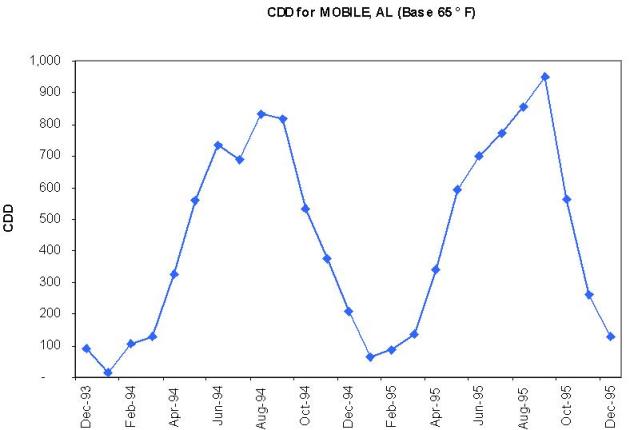
Figure 1.5 Cooling Degree Days
Base Year bills and Cooling Degree Days are then normalized by number of days, as shown in Figure 1.6. Normalizing by number of days (in this case, merely, dividing by number of days) removes any noise associated with different bill period lengths. This is done automatically by canned software, and would need to be performed by hand if other means were employed.

Figure 1.6: Finding the relationship between usage and weather data. The blue dots represent the utility bills. The red line is the best fit line.
To establish the relationship between usage and weather, we find the line that comes closest to all the bills. This line, the Best Fit Line, is found using statistical regression techniques available in canned utility bill tracking software and in spreadsheets.
The next step is to ensure that the Best Fit Line is good enough to use. The quality of the best fit line is represented by statistical indicators, the most common of which, is the R2 value. The R2 value represents the goodness of fit, and in energy engineering circles, an R2 > 0.75 is considered an acceptable fit. Some meters have little or no sensitivity to weather or may have other unknown variables that have a greater influence on usage than weather. These meters may have a low R2 value. You can generate R2 values for the fit line in Excel or other canned utility bill tracking software. [6]
This Best Fit Line has an equation, which we call the Fit Line Equation, or in this case the Baseline Equation. [7] The Fit Line Equation from Figure 1.6 might be:
Baseline kWh = ( 5 kWh/Day * #Days ) + ( 417 kWh/CDD * #CDD )
Once we have this equation, we are done with this regression process.
Let’s recap what we have done:
- We normalized Base Year utility bills and weather data for number of days in the bill.
- We graphed normalized Base Year utility data versus normalized weather data.
- We found a Best Fit Line through the data. The Best Fit Line then represents the utility bills for the Base Year.
- The Best Fit Line Equation represents the Best Fit Line, which in turn represents the Base Year of utility data.
Base Year bills ┰ˆ Best Fit Line = Fit Line Equation
The Fit Line Equation represents how your customer used energy during the Base Year, and would continue to use energy in the future (in response to changing weather conditions) assuming no significant changes occurred in building consumption patterns.
Once you have the Baseline Equation, you can determine if you saved any energy.
How? You take a bill from some billing period after the Base Year. You (or your software) plug in the number of days from your bill and the number of Cooling Degree Days from the billing period into your Baseline Equation.
Suppose for a current month’s bill, there were 30 days and 100 CDD associated with the billing period.
Baseline kWh = ( 5 kWh/Day * #Days ) + ( 417 kWh/CDD * #CDD )
Baseline kWh = ( 5 kWh/Day * 30 ) + ( 417 kWh/CDD * 100 )
Baseline kWh = 41,850 kWh
Remember, the Baseline Equation represents how your customer used energy in the Base Year. So, with the new inputs of number of days and number of degree days, the Baseline Equation will tell you how much energy the building would have used this year based upon Base Year usage patterns and this year’s conditions (weather and number of days). We call this usage that is determined by the Baseline Equation, Baseline Usage.
Now, to get a fair estimate of energy savings, we compare:
Savings = How much energy we would have used this year – How much energy we did use this year
or if we change the terminology a bit:
Savings = Baseline Energy Usage – Actual Energy Usage
where Baseline Energy Usage is calculated by the Baseline Equation, using current month’s weather and number of days, and Actual Energy Usage is the current month’s bill. Both equations immediately preceding are the same, as Baseline = “How much energy we would have used this year”, and Actual represents “How much energy we did use this year.”
So, using our example, suppose this month’s bill was for 30,000 kWh:
Savings = Baseline Energy Usage – Actual Energy Usage
Savings = 41,850 kWh – 30,000 kWh
Savings = 11,850 kWh
Calculating Degree Days and Finding the Balance Point
Cooling Degree Days (CDD) are roughly proportional to the energy used for cooling a building, while Heating Degree Days, (HDD) are roughly proportional to the energy used for heating a building. Degree Days, although simply calculated, are quite useful in energy calculations. They are calculated for each day, and then are summed over some period of time (months, a year, etc.). [8] In general, daily degree days are the difference between the building’s balance point and the average outside temperature. To understand degree days, then, we first need to understand the concept of Balance Points.

Figure 1.7: Determining the balance point using a kWh/day vs. Outdoor Temperature graph
Buildings have their own set of Balance Points for heating and for cooling – and they may not be the same. The Heating Balance Point can be defined as the outdoor temperature at which the building starts to heat. In other words, when the outdoor temperature drops below the Heating Balance Point, the building’s heating system kicks in. Conversely, when the outdoor temperature rises above the Cooling Balance Point, the building starts to cool. [9] A building’s balance point is determined by nearly everything associated with it, since nearly every component associated with a building has some effect on the heating of the building: building envelope construction (insulation values, shading, windows, etc.), temperature set points, thermostat set back schedules if any, the amount of heat producing equipment (and people) in the building, lighting intensity, ventilation, HVAC system type, HVAC system schedule, lighting and miscellaneous equipment schedules, among other factors.
In the past, before energy professionals used computers in their everyday tasks, degree day analysis was simplified by assuming balance points of 65°F for both heating and cooling. As a result, it was easy to publish and distribute degree days, since everyone calculated them using the same standard (that is, using 65°F as the balance point). It is more accurate, though, to recognize that every building has its own balance points, and to calculate degree days accordingly. Consequently, you are less likely to see degree days available, as more sophisticated analysis requires you to calculate your own degree days based upon your own building’s balance points. [10]
To find the balance point temperature of a building, graph the Usage/Day against Average Outdoor Temperature (of the billing period) as shown in Figure 1.7. Notice that Figure 1.7 presents two trends. One trend is flat, and the other trend slopes up and to the right. We have drawn red lines signifying the two trends in Figure 1.8. (Ignore the vertical red line for now.)The flat trend represents Non-Temperature Sensitive Consumption, which is electrical consumption that is not related to weather. In Figure 1.7, Non-Temperature Sensitive Consumption is roughly the same every month, about 2450 kWh per day. Examples of Non-Temperature Sensitive Consumption include lighting, computers, miscellaneous plug load, industrial equipment and well pumps. Any usage above the horizontal red line is called Temperature Sensitive Consumption, which represents electrical usage associated with the building’s cooling system. Notice that in Figure 1.8, the Temperature Sensitive Consumption only occurs at temperatures greater than 61°F. The intersection of the two trends is called the Balance Point, or Balance Point Temperature, which is 61°F in this example.
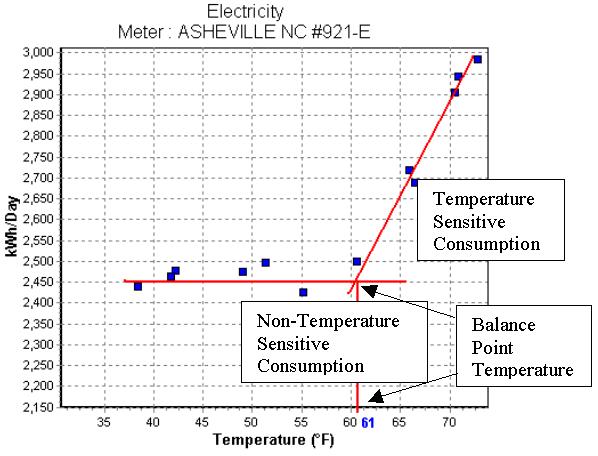
Figure 1.8: kWh /day vs Average Outdoor Temperature
Notice also that, in Figure 1.8, as the outdoor temperature increases, consumption increases. As it gets hotter outside, the building uses more energy, thus the meter is used for cooling, but not heating. The Balance Point Temperature we found is the Cooling Balance Point Temperature (not the Heating Balance Point Temperature).

Figure 1.9: kWh/day vs Average Outdoor Temperature
We can view the same type of graph for heating usage in Figure 1.9. Notice that the major difference between the two graphs, is that the Temperature Sensitive trend slopes up and to the left (rather than up and the right). As the outdoor temperature drops, the building use more electricity to heat the building.
Now that we have established our balance point temperature, we have all the information required to calculate Degree Days. If your graph resembles Figures 1.9, you will be using Heating Degree Days. If your graph resembles Figure 1.8, you will be using Cooling Degree Days. [11]
Normalizing For Other Variables
More and more energy professionals are coming to understand the value of normalizing utility data for production in addition to (or instead of) weather. This works if you have a simple variable that quantifies your production. For example, a computer assembly plant can track the number of computers produced. If a factory manufactures several different products, for example, disk drives, desktop computers, and printers, it may be difficult to come up with a single variable that could be used to represent production for the entire plant (i. e. tons of product). However, since analysis is performed on a meter level rather than a plant level, if you have meters (or submeters) that serve just one production line, then you can normalize usage from one meter with the product produced from that production line.
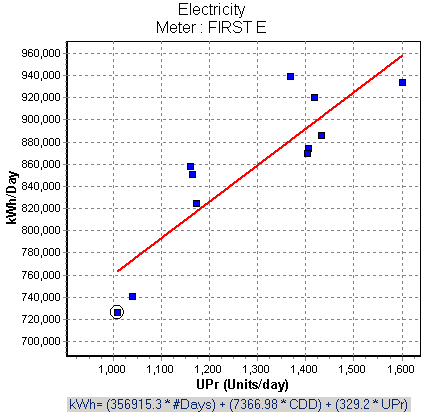
Figure 1.10 Daily Usage Normalized to Production and Weather.
The Baseline Equation is shown at the bottom of the figure
Figure 1.10 presents normalized daily usage versus production for a widget factory. The baseline equation for this normalization is shown at the bottom of the figure. Notice that Units of Production (UPr) as well as Cooling Degree Days (CDD) are included in the equation, meaning that this normalization included weather data and production data.
School districts, colleges, and universities often normalize for the school calendar. Real estate concerns, hotels and prisons normalize for occupancy. Essentially any variable can be used for normalization, as long as it is an accurate, consistent predictor of energy usage patterns.
Again, these normalizations can be performed by specialized utility bill tracking software, or using spreadsheets.
Conclusion
Weather varies from year to year. As a result, it becomes difficult to know whether the change in your utility bills is due to fluctuations in weather, or due to your alternative energy system, or both. If you wish to use utility bills to determine energy savings from your alternative energy system with any degree of accuracy, it is vital that you remove the variability of weather from your energy savings equation. This is done using the weather normalization techniques described in this paper. You may adjust your usage for other variables as well, such as occupancy or production.
About The Author
John Avina, Director of Abraxas Energy Consulting, has worked in energy analysis and utility bill tracking for over a decade. Mr. Avina performed M&V for Performance Contracting at Johnson Controls. In later positions with SRC Systems, Silicon Energy and Abraxas Energy Consulting, he has taught well over 200 software classes, handled technical support for nearly a decade, assisted with product development, and wrote manuals for Metrix Utility Accounting System™. Mr. Avina managed the development of new analytical software that employed the weather regression algorithms found in Metrix™ to automatically calibrate building models. In October 2001, Mr. Avina, and others from the defunct SRC Systems, founded Abraxas Energy Consulting. Mr. Avina has a MS in Mechanical Engineering from the University of Wisconsin-Madison, where he was a research assistant at the Solar Energy Lab. He is a Member of the American Society of Heating Refrigeration and Air-Conditioning Engineers (ASHRAE), the Association of Energy Engineers (AEE), and a Certified Energy Manager (CEM).
Abraxas Energy Consulting (www. abraxasenergy. com) sells all of the major desktop utility bill tracking software programs, including EnergyCAP© Desktop, Metrix™, and Stark Essentials™. Abraxas Energy Consulting specializes in helping their clients find the right utility bill tracking program, setting up clients’ utility bill tracking databases, and providing energy analysis and mentoring. The company also provides engineering services such as measurement and verification for ESCOs, utility bill tracking, building energy audits, utility bill auditing, software and energy analysis training, and related custom software applications.
[1] What are the alternatives? The most common might involve determining savings for each of the energy conservation activities using a spreadsheet, or perhaps even a building model. Both of these alternative strategies could require much additional work, as the alternative energy contractor likely has employed several strategies over his tenure. One other drawback of spreadsheets is that energy conservation strategies may interact with each other, so that total savings may not be the sum of the different strategies, and finally, spreadsheets are often projections of energy savings, not measurements.
[2] Cooling degree days are defined in detail later in the chapter, however a rough meaning is given here. Cooling Degree Days are a rough measure of how much a period’s weather should result in a building’s cooling requirements. A hotter day will result in more Cooling Degree Days, whereas a colder day may have no Cooling Degree Days. Double the amount of Cooling Degree Days should result in roughly double the cooling requirements for a building. Cooling Degree Days are calculated individually for each day. Cooling Degree Days over a month or billing period, are merely a summation of the Cooling Degree Days of the individual days. The same is true for Heating Degree Days.
[3] Some energy professionals select 2 years of bills rather than one. Good reasons can be argued both for choosing one year or two years. Do not choose periods of time that are not in intervals of 12 months (for example, 15 months, or 8 months could lead to inaccuracy).
[4] Please do not confuse Base Year with Baseline. Base Year is a time period, from which bills were used to determine the building’s energy usage patterns with respect to weather data, whereas Baseline, as will be described later, represents how much energy we would have used this month, based upon Base Year energy usage patterns, and current month conditions (i. e. weather and number of days in the bill).
[5] Canned software does this automatically for you, while in spreadsheets, this step can be tedious.
[6] The statistical calculations behind the R2 value, and a treatment of three other useful indicators, T-Statistic, Mean Bias Error, and CVRMSE are not treated in this chapter. For more information on these statistical concepts, consult any college statistics textbook. (For energy contractors, a combination of R2 values and T-Statistics is usually enough. )
[7] Baseline Equation = Fit Line Equation +/- Baseline Modifications. We cover Baseline Modifications later in this chapter.
[8] You would not sum or average high or low temperatures for a period of time, as the result would not be useful. However, you can sum degree days, and the result remains useful, as it is proportional to the heating or cooling requirements of a building.
[9] If you think about it, you don’t have to treat this at the building level, but rather can view it at a meter level. (To simplify the presentation, we are speaking in terms of a building, as it is less abstract. )Some buildings have many meters, some of which may be associated with different central plants. In such a building, it is likely that the disparate central plants would have different balance points, as conditions associated with the different parts of the building may be different.
[10] Some analysts had separate tables of degree days based upon a range of balance points (65, 60, 55, etc. ), and analyzed their data painstakingly with several balance points until they found the best balance point temperature for their building. On the other hand, some believe that all degree days are calculated assuming the standard balance point of 65°F.
[11] If you calculate degree days by hand, or using a spreadsheet, you would use the following formulae for your calculations. Of course, commercially available software that performs weather nomalization handles this automatically.
For each day,
- HDDi = [ TBP-( Thi + Tlo ) / 2 ] x 1 Day+
- CDDi =[ ( Thi + Tlo ) / 2 – TBP ] x 1 Day+
Where:
- HDDi = Heating Degree Days for one day
- CDDi = Heating Degree Days for one day
- TBP = Balance Point Temperature,
- Thi = Daily High Temperature
- Tlo = Daily Low Temperature
- +signifies that you can never have negative degree days. If the HDDi or CDDi calculation yields a negative number, then the result is 0 degree days for that day
Heating and Cooling Degree Days can be summed, respectively, over several days, a month, a billing period, a year, or any interval greater than a day. For a billing period (or any period greater than a day),
- HDD = SHDDi
- CDD = SCDDi
Take a look back to Figure 1.3, where you may have noticed that there are more than twice as many Cooling Degree Days (CDD) in August 2005 than in August 2004. Because Cooling Degree Days are roughly proportional to a building’s cooling energy usage, one could rightly assume that the cooling requirements of the building would be roughly double as well.